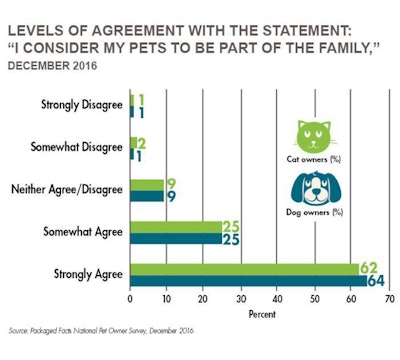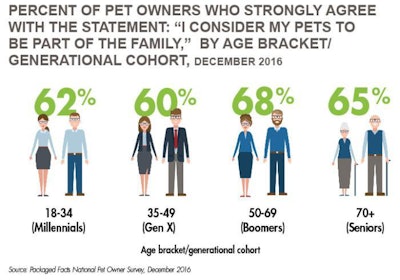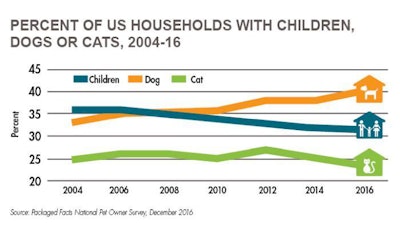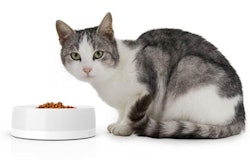
There is not much feud over pets as family, and Packaged Facts’ December 2016 national survey of pet owners shows that the term “pet parent” is hardly stretching things: Nearly two-thirds of dog or cat owners “strongly agree” that they consider their pets to be part of the family, and another fourth at least “somewhat agree.”
Conversely, the level of active disagreement—strongly or somewhat disagreeing that pets are family—is not much higher than trivial.

A majority of dog and cat owners "strongly agree" that their pets are part of the family.
Moreover, this pattern holds across the generational age cohorts — from elderly seniors to Gen Zers who are just now stepping into adulthood. Importantly, even so, the sentiment is a notch lower among Gen Xers, the generation most likely to have children at home, and a notch stronger among baby boomers, many of whom are in the empty nest stage.

Sixty-eight percent of boomers and 65 percent of seniors "strongly agree" that they consider their pets family, many of whom are empty nesters, compared with the 60 percent of Gen Xers, more likely to children at home.
These modulations by lifestage put some meat on the bones of (mostly) tongue-in-cheek bumper stickers, such as “My dog is smarter than your honor student.” While pets aren’t children, they have for the contemporary American household taken on some of kids’ and grandkids’ traditional role as “apple of the eye” (and some of the “tons of trouble” flipside of that coin, too).
Several factors have driven this development, including the trends toward single-person households, postponed marriage, fewer children per family household, telecommuting made possible by technology, and longer adult lifespans that hurdle long past the conventional child-bearing or employment years. New-style households are another factor: Packaged Facts estimates that 68 percent of gay or lesbian couples (married or living together) have dogs or cats, compared with 55 percent of households overall.
With these factors, the table has turned on which creatures are most likely to be begging for treats in US households. In 2004, 36 percent of households had children, edging out the 33 percent with dogs. As of 2016, 32 percent of US households had children, while 40 percent had dogs.

The percent of dogs in US housholds has grown since 2004 to outpace the percentage of children in 2016.
The impact of the “pet parent” mindset on pet care and the pet industry is wide-ranging. For example, Packaged Facts' survey data from December 2016 show that:
- 67 percent of dog or cat owners who “strongly” agree that their pets are part of the family prefer to buy pet vitamins/supplements that are made in the USA, compared with 43 percent who “somewhat” agree, and only 25 percent of those who do not agree.
- 57 percent of cat owners who “strongly” agree that their pets are part of the family keep their pet food in the kitchen/pantry, compared with 50 percent who “somewhat” agree, and only 42 percent of those who do not agree.
- 33 percent of dog or cat owners who “strongly” agree that their pets are part of the family also strongly agree that targeted pet foods/treats with special nutrition are beneficial to pets with specific health needs, compared with 14 percent who “somewhat” agree, and 4 percent of those who do not agree.
- 19 percent of dog or cat owners who “strongly” agree that their pets are part of the family purchase dental/oral health pet treats, compared with 17 percent who “somewhat” agree, and 13 percent of those who do not agree.
As notably, two-thirds (65 percent) of dog or cat owners who “strongly” agree that their pets are part of the family also strongly agree that pets have a positive impact on their mental health, compared with a fifth (19 percent) who “somewhat” agree, and a mere single-digit share (7 percent) of those who haven’t seen their way to pet parenthood.
Insights on the market implications of the “pet parent” will be one component of “Taste of Pet Food’s Future” Innovation Workshop (April 3) at the 2017 Petfood Forum.
More on Petfood Innovation workshop:

















